
Chile's government is a representative democratic republic, whereby the President of Chile is both head of state and head of government, and of a formal multi-party system. Executive power is exercised by the president and his or her cabinet. Legislative power is vested in both the government and the two chambers of the National Congress. The judiciary is independent of the executive and the legislature of Chile.
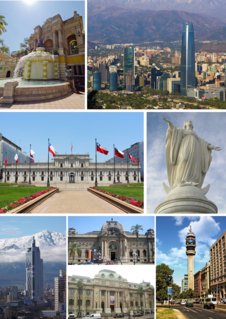
Santiago, also known as Santiago de Chile, is the capital and largest city of Chile as well as one of the largest cities in the Americas. It is the center of Chile's most densely populated region, the Santiago Metropolitan Region, whose total population is 7 million, of which more than 6 million live in the city's continuous urban area. The city is entirely in the country's central valley. Most of the city lies between 500–650 m (1,640–2,133 ft) above mean sea level.

Viña del Mar is a city and commune on central Chile's Pacific coast. Often referred to as La Ciudad Jardín, Viña del Mar is located within the Valparaíso Region, and it is Chile's fourth largest city with a population of 324,836. Viña del Mar is also part of the Greater Valparaíso area, the country's third largest metropolitan area, after the Metropolitan areas of Santiago and Concepción. The Greater Valparaíso Area is home to five municipalities: Valparaíso, Viña del Mar, Concon, Quilpue and Villa Alemana.

Palacio de La Moneda, or simply La Moneda, is the seat of the President of the Republic of Chile. It also houses the offices of three cabinet ministers: Interior, General Secretariat of the Presidency and General Secretariat of the Government. It occupies an entire block in downtown Santiago, in the area known as Civic District between Moneda, Morandé (East), Alameda del Libertador Bernardo O'Higgins (South) and Teatinos street (West).
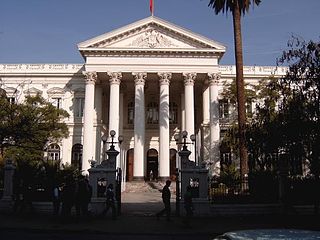
The Former National Congress Building is the former home of the Chilean Congress. Congress met in this building in central Santiago until Salvador Allende's socialist government was overthrown by Augusto Pinochet's military coup d'état on September 11, 1973.

Estación Mapocho is a former railway station that, since 1994, has been refitted as a cultural centre that hosts many kinds of events.
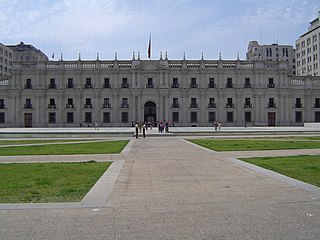
Plaza de la Ciudadanía is a public square located in the southern façade of the Palacio de La Moneda in Santiago. It used to be part of the grass garden and parking area of the Palace.
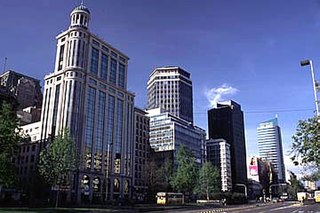
Avenida Libertador General Bernardo O'Higgins, popularly known as La Alameda, is the main avenue of Santiago, Chile. It runs east-west in the center of the greater urban area and is 7.77 km (4.83 mi) long, and it has up to 5 lanes in each direction. It was named after Chile's founding father Bernardo O'Higgins. It was originally a branch of the Mapocho River.

The Chilean National Museum of Fine Arts, located in Santiago, Chile, is one of the major centers for Chilean art and for broader South American art. Established in 1880, the organization is managed by the "Artistic Union".
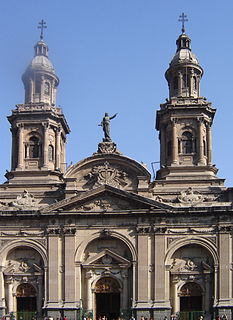
Santiago Metropolitan Cathedral is the seat of the Archbishop of Santiago de Chile, currently Celestino Aós Braco, and the center of the archdiocese of Santiago de Chile. Construction of the neoclassical cathedral began in 1753 and ended in 1799. The architect was the Italian Gioacchino Toesca. Further alterations ordered at the end of the 19th century gave it its present appearance. Previous cathedrals in the archdiocese had been destroyed by earthquakes.

The Palacio de la Real Audiencia de Santiago is a building located in the north central village of the Plaza de Armas in Santiago, Chile. The building dates back to 1808 and houses, since 1982, the National History Museum of Chile.

The Plaza de Armas is the main square of Santiago, the capital of Chile. It is the centerpiece of the initial layout of Santiago, which has a square grid pattern. This urban design was accomplished by Pedro de Gamboa, which was appointed by Pedro de Valdivia in 1541.

The Central Post Office Building is a historic post office building on the northern edge of the Plaza de Armas, in Santiago, Chile. It is adjacent to the Palacio de la Real Audiencia de Santiago and is located on what was the land lot originally owned by Pedro de Valdivia and where he built his house. The site also was occupied by a building that served as Presidential Palace until 1846. Construction of the current building began in 1881 and was designed by Ricardo Brown. Its current appearance dates to 1908.

The Palacio de los Tribunales de Justicia de Santiago is the building housing the Supreme Court of Chile, the Court of Appeals of Santiago, and the Court-martial Court of the Chilean Army, Chilean Air Force and Carabineros de Chile. It occupies a full block-front of Compañía Street between Bandera and Morandé Streets. The building diagonally faces the Palacio de la Real Aduana, which houses the Museo Chileno de Arte Precolombino, and Montt Varas Square sits in front.

The Palacio Cousiño is a palace that was designed and built for Isidora Goyenechea, widow of Luis Cousiño, who in turn was son of Matías Cousiño. It is located at 438 Dieciocho Street in Santiago, Chile.

Barrio Lastarria is an historical neighborhood in the center of Santiago, Chile. Now a popular tourist hub, Barrio Lastarria is a center for cultural activity, with cinemas, theaters, museums, restaurants and bars. Activities such as festivals and live performances are commonly held throughout the streets of Lastarria given its strong cultural flavor, particularly in J.V. Lastarria street and Parque Forestal.

The Santiago Museum of Contemporary Art is located in Santiago, Chile. It is one of the city's major museums, created in 1947, and is run by the University of Chile Faculty of Arts. Since 2005, the museum has had two separate sites: MAC Parque Forestal and MAC Quinta Normal Park.

The Palace of Cerro Castillo is the official country retreat and summer residence of the President of Chile. Constructed in 1929 in the Spanish Colonial Revival style, it is located in Viña del Mar and is a national and municipal historic monument.
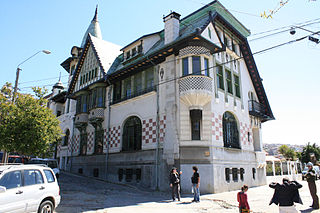
Palacio Baburizza is the former residence of Croatian businessman Pascual Baburizza located in Valparaíso, Chile. It was built in 1916 by Italian architects, and eventually turned into a museum in 1971, and declared a historic monument in 1976.
Chilean architecture is influenced by the country's history, religious culture and unique climate. Chile used to be a Spanish colony and its architectural style was therefore strongly influenced by Spanish design. Due to the unique geographical environment, Chilean architecture will be adjusted according to natural conditions. Its special geological structure makes Chile the country with the highest incidence of earthquakes and tsunamis, so Chilean architects have excellent experience in the application of structures and materials for earthquake-resistant structures and post-disaster reconstruction.



















